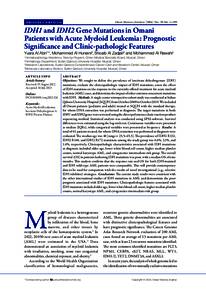Document
IDH1 and IDH2 gene mutations in Omani patients with acute myeloid leukemia: Prognostic significance and clinicopathologic features.
Identifier
DOI 10.5001/omj.2023.126
Source
Oman Medical Journal, v. 39, no. 1, e592 p. [1-7].
Contributors
Country
Oman
City
Muscat
Publisher
Oman Medical Specialty Board.
Gregorian
2024-01-01
Language
English
Subject
English abstract
We sought to define the prevalence of isocitrate dehydrogenase (IDH)
mutations, evaluate the clinicopathologic impact of IDH mutations, assess the effect
of IDH mutations on the response to the currently offered treatment for acute myeloid
leukemia (AML) cases, and determine the impact of other common concurrent mutations
with IDH. Methods: A single-center retrospective cohort study was conducted at Sultan
Qaboos University Hospital (SQUH) from October 2009 to October 2019. We included
all Omani patients (pediatric and adult) treated at SQUH with the standard therapy,
for whom DNA extraction was performed at diagnosis. The target mutations in both
IDH1 and IDH2 genes were screened using the direct polymerase chain reaction product
sequencing method. Statistical analysis was conducted using SPSS software. Survival
differences were estimated using the log-rank test. Continuous variables were presented
as median (IQRs), while categorical variables were presented as frequency. Results: A
total of 61 patients treated, for whom DNA extraction was performed at diagnosis were
evaluated. The median age was 40 (range = 25.5–65.5). The prevalence of IDH1 R132,
IDH2 R140, and IDH2 R172 mutations among the study group was 6.6%, 3.3%, and
1.6%, respectively. Clinicopathologic characteristics associated with IDH mutations
at diagnosis included older age, lower white blood cell count, higher median platelet
counts, normal karyotype AML, and cytogenetics intermediate-risk group. The overall
survival (OS) in patients harboring IDH mutations was poor, with a median OS of nine
months. This analysis confirms that the response rate and OS for both IDH-mutated
and IDH wild-type AML patients were comparable. This will provide contemporary
data to be used for comparison with the results of novel investigational (e.g., selective
IDH inhibitor) strategies. Conclusions: The current study results were consistent with
the other international studies of IDH mutations in AML and demonstrate the poor
prognosis associated with IDH mutations. Clinicopathologic features associated with
IDH mutations included older age, lower white blood cell count, higher median platelet
counts, normal karyotype AML, and cytogenetics intermediate-risk group.
ISSN
1999-768X (Print)
2070-5204 (Electronic)
Category
Journal articles

